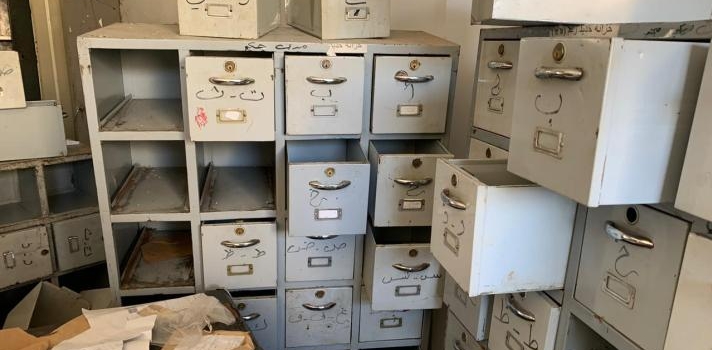Archiving Atrocity: What should be done with the Archives of the Assad Regime?
By Uğur Ümit Üngör
June 27, 2025

On 8 December 2024, the unimaginable happened: the Syrian dictator Bashar al-Assad fled to Moscow and his regime collapsed. The tens of thousands of staff in his military and intelligence empire collectively abandoned their posts, disappearing into the night, or in other cases: Dubai, Lebanon, Russia, and Iran. Next to the unfinished cups of coffee on their tables were documents that represented pages in a huge bureaucracy of violence. They did not burn, destroy, hide, smuggle, or sell them, but simply deserted the documentary record of Assad’s terror apparatus.
Assad’s four main intelligence services, State Security, Political Security, Military Security, and the Air Force Intelligence, were collectively known as Mukhabarat. Nationwide, this quartet operated prisons and detention centers where torture was routinely applied against detainees. What distinguished Assad’s intelligence services from many of their counterparts elsewhere was primarily by their broad powers to use deadly force against Syrian citizens. Like others, they were allowed to wiretap and spy on citizens, but they also threatened, manipulated, arrested, and imprisoned citizens, often without warrants or due process.
It was a system of governance built on fear, to be sure, but also banality and routine. Surveillance reports, written in dry, bureaucratic language, detailed the minutiae of citizens’ lives from what they bought at the market, whom they met for coffee, what they posted on social media. Innocuous offenses, such as telling jokes about Assad, next to more serious ones, like organizing demonstrations. There were daily dispatches from mosques, to inform on worshipers. Interrogation logs, equally clinical, describe the calculated psychological torments used to extract confessions: the hours of sleep deprivation, the precise application of electric shocks. Budget sheets allocate funds for torture equipment and propaganda campaigns with the dispassionate efficiency of public utilities.
The first viewers of the archives, i.e. those daring to breach the building right after the agents left, oscillated between a measured surprise (it was worse than we thought) alongside an exasperation (what the hell are we supposed to do with this). Like ebb and flow, their initial emotional reaction was quickly washed over by a rational wonder, and back again. These first responders quickly understood that whatever miserable history the Mukhabarat archives concealed, they should be considered the public property of the Syrian people. What that actually means, practically and ideologically, is dizzying to contemplate.
For scholars and historians, the Mukhabarat archives offer an unprecedented opportunity to study the anatomy of a 21st-century authoritarian regime in the Middle East. After all, the Islamic Republic of Iran or the Kingdom of Saudi Arabia will not be giving up their archival secrets anytime soon. But for Syria, we will be able to expose and examine the inner workings of a regime that thrived on secrecy and fear, and to parse the layers of complicity or blindness that sustained it for over five decades. This archive will yield some of the most counterintuitive yet poignant historical insights about how this regime established a veritable Gulag prison system, or tortured people en masse, or set up sectarian militias, or used chemical weapons.
In 2017, I wrote an essay about how the struggle for the truth in Syria required a clear research agenda in the case the Assad regime would fall. The sudden availability of the regime’s archives are a clear opportunity to achieve precisely that: to research the architecture of the regime’s violence and the bureaucrats and functionaries who carried out Assad’s orders. And they will yield uncomfortable truths, post-truths, entangled histories, and puzzles that might remain unsolvable. Without such truth-seeking and truth-finding, we cannot know, understand, account for, the tremendous injustices the regime visited upon Syrian society. There is a long way ahead.